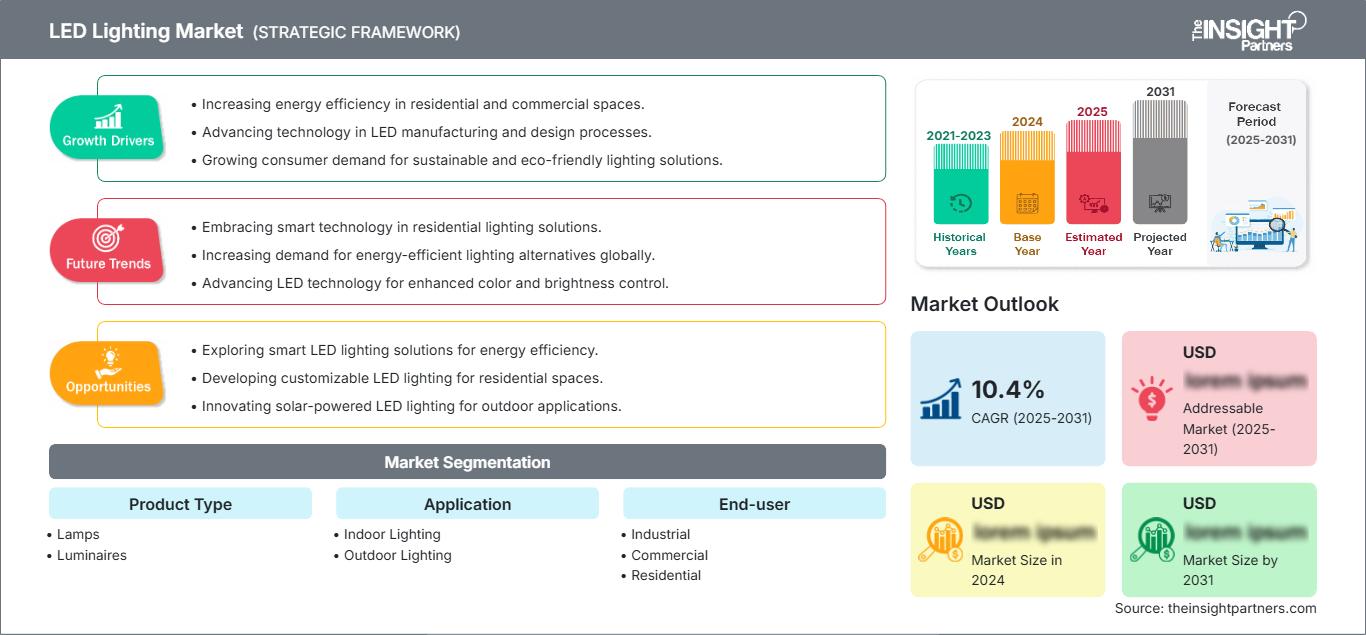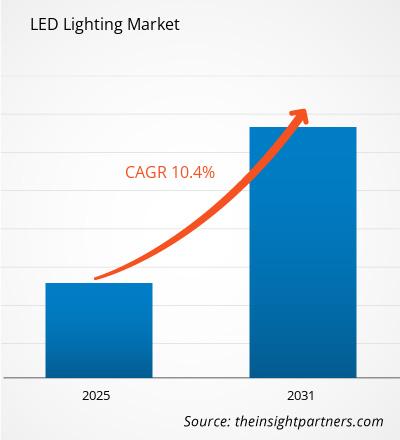Si prevede che il mercato dell'illuminazione a LED registrerà un CAGR del 10,4% dal 2025 al 2031, con una dimensione del mercato in espansione da XX milioni di dollari nel 2024 a XX milioni di dollari entro il 2031.
Il rapporto è segmentato per tipologia di prodotto (lampade, apparecchi di illuminazione), applicazione (illuminazione per interni, illuminazione per esterni), utente finale (industriale, commerciale, residenziale, enti governativi). Il rapporto offre il valore in USD per l'analisi e i segmenti sopra indicati.
Scopo del rapporto
Il rapporto sul mercato dell'illuminazione a LED di The Insight Partners mira a descrivere il panorama attuale e la crescita futura, i principali fattori trainanti, le sfide e le opportunità. Ciò fornirà spunti a vari stakeholder aziendali, come:
- Fornitori/produttori di tecnologia: per comprendere le dinamiche di mercato in evoluzione e conoscere le potenziali opportunità di crescita, consentendo loro di prendere decisioni strategiche informate.
- Investitori: per condurre un'analisi completa delle tendenze in merito al tasso di crescita del mercato, alle proiezioni finanziarie del mercato e alle opportunità esistenti lungo la catena del valore.
- Organismi di regolamentazione: per regolamentare le politiche e le attività di controllo nel mercato con l'obiettivo di ridurre al minimo gli abusi, preservare la fiducia degli investitori e sostenere l'integrità e la stabilità del mercato.
Segmentazione del mercato dell'illuminazione a LED Tipo di prodotto
- Lampade
- Apparecchi di illuminazione
Applicazione
- Illuminazione per interni
- Illuminazione per esterni
Utente finale
- Industriale
- Commerciale
- Residenziale
- Enti governativi
Geografia
- Nord America
- Europa
- Asia-Pacifico
- America meridionale e centrale
- Medio Oriente e Africa
Potrai personalizzare gratuitamente qualsiasi rapporto, comprese parti di questo rapporto, o analisi a livello di paese, pacchetto dati Excel, oltre a usufruire di grandi offerte e sconti per start-up e università
Mercato dell'illuminazione a LED: Approfondimenti strategici

- Ottieni le principali tendenze chiave del mercato di questo rapporto.Questo campione GRATUITO includerà l'analisi dei dati, che vanno dalle tendenze di mercato alle stime e alle previsioni.
Fattori di crescita del mercato dell'illuminazione a LED
- Crescente consapevolezza dell'efficienza energetica: uno dei principali fattori trainanti del mercato dell'illuminazione a LED è la crescente consapevolezza dell'efficienza energetica tra consumatori e aziende. Le luci a LED consumano molta meno energia rispetto alle tradizionali lampadine a incandescenza o fluorescenti, il che si traduce in bollette elettriche più basse e un impatto ambientale ridotto. Con l'implementazione da parte dei governi di tutto il mondo di obblighi e incentivi per promuovere soluzioni di illuminazione a risparmio energetico, i consumatori sono sempre più propensi a passare alla tecnologia LED, trainando la crescita del mercato.
- Crescente urbanizzazione e crescente sviluppo delle infrastrutture: con il continuo aumento dell'urbanizzazione a livello globale, aumenta la domanda di soluzioni di illuminazione efficienti e affidabili per le infrastrutture urbane. Le città stanno investendo in moderni sistemi di illuminazione per migliorare la sicurezza pubblica, l'estetica e ridurre il consumo energetico. L'illuminazione a LED è particolarmente adatta agli ambienti urbani grazie alla sua durata, alla ridotta necessità di manutenzione e alla capacità di fornire un'illuminazione di alta qualità. Questa tendenza all'urbanizzazione e allo sviluppo infrastrutturale sta guidando l'adozione di soluzioni di illuminazione a LED nelle città di tutto il mondo.
Tendenze future del mercato dell'illuminazione a LED
- Ascesa delle soluzioni di illuminazione intelligente: la tendenza verso l'illuminazione intelligente sta prendendo piede nel mercato dell'illuminazione a LED. Con l'integrazione della tecnologia IoT, i sistemi di illuminazione a LED intelligenti consentono agli utenti di controllare la propria illuminazione da remoto tramite smartphone o altri dispositivi. Questa funzionalità consente funzioni come la dimmerazione, il cambio di colore e la programmazione, offrendo agli utenti maggiore praticità e gestione energetica. Poiché i consumatori cercano sempre più esperienze di illuminazione personalizzate ed efficienti, si prevede che la domanda di soluzioni LED intelligenti continuerà a crescere.
- Focus su soluzioni sostenibili ed ecocompatibili: la sostenibilità è una tendenza significativa che influenza il mercato dell'illuminazione a LED, poiché sia i consumatori che le aziende stanno dando priorità ai prodotti ecocompatibili. I LED sono privi di materiali pericolosi come il mercurio, comunemente presente nelle tradizionali lampade fluorescenti, e hanno un'impronta di carbonio molto inferiore grazie alla loro natura efficiente dal punto di vista energetico. Questa crescente attenzione alle soluzioni di illuminazione sostenibili sta spingendo i produttori a innovare e promuovere i benefici ambientali della tecnologia LED, stimolando ulteriormente la crescita del mercato.
Opportunità di mercato per l'illuminazione a LED
- Adozione in applicazioni commerciali e industriali: i settori commerciale e industriale offrono notevoli opportunità per il mercato dell'illuminazione a LED. Le aziende stanno riconoscendo sempre più i vantaggi della tecnologia LED, tra cui minori costi energetici e minori esigenze di manutenzione. Dagli uffici agli stabilimenti di produzione, la transizione all'illuminazione a LED sta diventando sempre più diffusa, poiché le aziende cercano di migliorare l'efficienza operativa e la sostenibilità. Rivolgendosi a questi settori, i produttori possono capitalizzare sulla crescente domanda di soluzioni di illuminazione a basso consumo energetico.
- Crescenti applicazioni innovative nell'illuminazione decorativa e architettonica: la versatilità della tecnologia LED apre numerose opportunità nelle applicazioni di illuminazione decorativa e architettonica. Grazie ai progressi nella miscelazione dei colori, negli effetti di luce dinamici e nella controllabilità, i LED possono essere utilizzati in modo creativo per migliorare l'estetica sia negli spazi residenziali che commerciali. Ciò include applicazioni come l'illuminazione d'atmosfera, l'illuminazione d'accento e persino le installazioni artistiche. Poiché consumatori e designer sono sempre più alla ricerca di soluzioni di illuminazione uniche e personalizzabili, è probabile che la domanda di prodotti LED innovativi in contesti decorativi cresca in modo sostanziale.
Approfondimenti regionali sul mercato dell'illuminazione a LED
Le tendenze regionali e i fattori che influenzano il mercato dell'illuminazione a LED durante il periodo di previsione sono stati ampiamente spiegati dagli analisti di The Insight Partners. Questa sezione analizza anche i segmenti e la geografia del mercato dell'illuminazione a LED in Nord America, Europa, Asia-Pacifico, Medio Oriente e Africa, America Meridionale e Centrale.
Ambito del rapporto sul mercato dell'illuminazione a LED
| Attributo del rapporto | Dettagli |
|---|---|
| Dimensioni del mercato in 2024 | US$ XX million |
| Dimensioni del mercato per 2031 | US$ XX Million |
| CAGR globale (2025 - 2031) | 10.4% |
| Dati storici | 2021-2023 |
| Periodo di previsione | 2025-2031 |
| Segmenti coperti |
By Tipo di prodotto
|
| Regioni e paesi coperti | Nord America
|
| Leader di mercato e profili aziendali chiave |
|
Densità degli operatori del mercato dell'illuminazione a LED: comprendere il suo impatto sulle dinamiche aziendali
Il mercato dell'illuminazione a LED è in rapida crescita, trainato dalla crescente domanda degli utenti finali, dovuta a fattori quali l'evoluzione delle preferenze dei consumatori, i progressi tecnologici e una maggiore consapevolezza dei vantaggi del prodotto. Con l'aumento della domanda, le aziende stanno ampliando la propria offerta, innovando per soddisfare le esigenze dei consumatori e sfruttando le tendenze emergenti, alimentando ulteriormente la crescita del mercato.

- Ottieni il Mercato dell'illuminazione a LED Panoramica dei principali attori chiave
Punti di forza
- Copertura completa: il rapporto analizza in modo esaustivo prodotti, servizi, tipologie e utenti finali del mercato dell'illuminazione a LED, offrendo una panoramica olistica.
- Analisi degli esperti: il rapporto è redatto sulla base della conoscenza approfondita di esperti e analisti del settore.
- Informazioni aggiornate: il rapporto garantisce la pertinenza aziendale grazie alla copertura di informazioni e dati recenti.
- Opzioni di personalizzazione: questo rapporto può essere personalizzato per soddisfare le esigenze specifiche del cliente e adattarsi in modo appropriato alle strategie aziendali.
Il rapporto di ricerca sul mercato dell'illuminazione a LED può quindi contribuire a guidare il percorso di decodificazione e comprensione dello scenario del settore e delle prospettive di crescita. Sebbene possano esserci alcune preoccupazioni valide, i vantaggi complessivi di questo rapporto tendono a superare gli svantaggi.
- Analisi storica (2 anni), anno base, previsione (7 anni) con CAGR
- Analisi PEST e SWOT
- Valore/volume delle dimensioni del mercato - Globale, Regionale, Nazionale
- Industria e panorama competitivo
- Set di dati Excel
Report recenti
Testimonianze
Motivo dell'acquisto
- Processo decisionale informato
- Comprensione delle dinamiche di mercato
- Analisi competitiva
- Analisi dei clienti
- Previsioni di mercato
- Mitigazione del rischio
- Pianificazione strategica
- Giustificazione degli investimenti
- Identificazione dei mercati emergenti
- Miglioramento delle strategie di marketing
- Aumento dell'efficienza operativa
- Allineamento alle tendenze normative




















 Ottieni un campione gratuito per - Mercato dell'illuminazione a LED
Ottieni un campione gratuito per - Mercato dell'illuminazione a LED